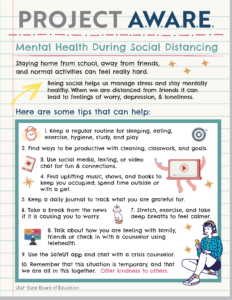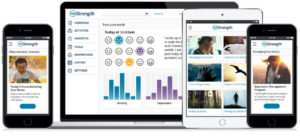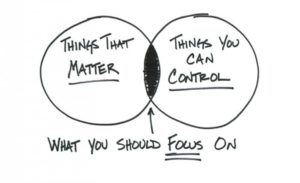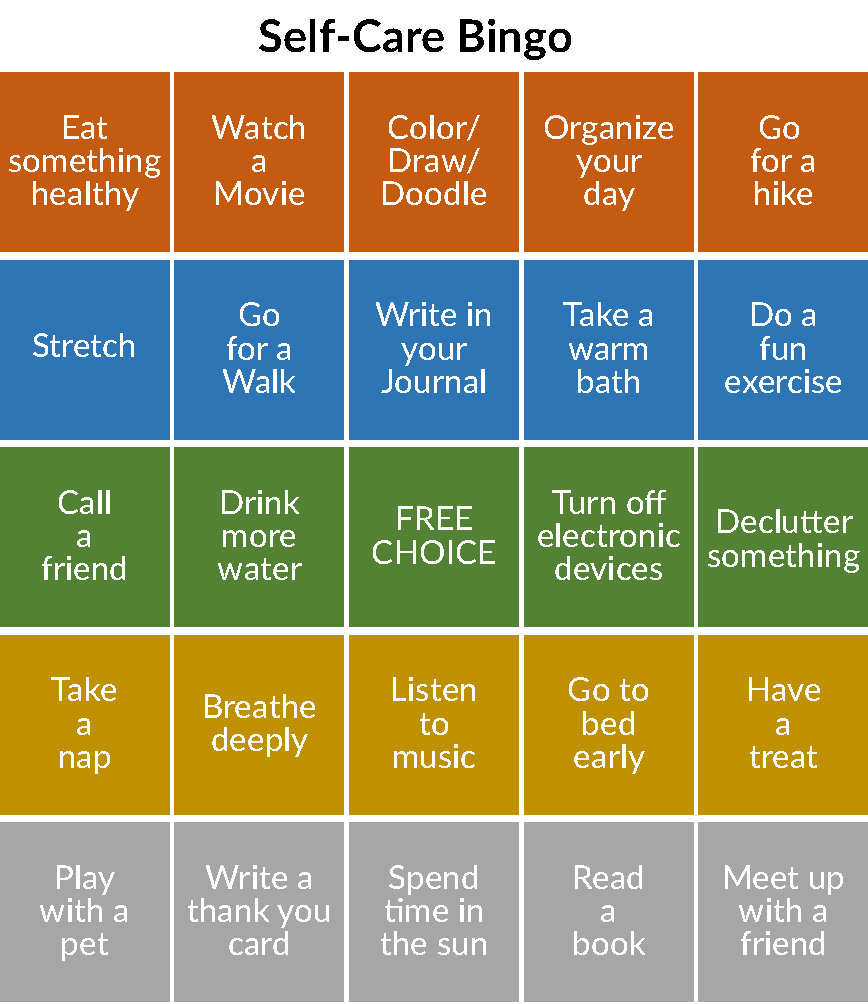For weekly tips for wellness at home, join us for Tuesday Tips - a less than 30-minute virtual lunch n' learn. All of our Tuesday Wellness Tips are recorded and posted on our Tuesday Tips page. Visit the page to sign up.
Click here for a comprehensive list of available community resources for health, housing, unemployment, food assistance, as well as other available help.
Lista de recursos COVID-19 para la comunidad
For resources related to at-home learning, please visit our District's Digital Learning page. Here are some additional tips for homeschooling during this unique time.
General Tips for Home-Centered Wellness related to COVID-19

- For tips that are directed towards students, please review the flyer to the left put together by our ProjectAWARE grant partners.
- For ideas for talking to your children about COVID-19 refer to these tips from Intermountain Healthcare. You could also use this brief comic to help children understand the virus. It is good to talk openly and honestly with children while sticking to the facts and stating what we DO know about the virus because misinformation and rumors can add to feelings of anxiousness.
- Check out this link for a Coronavirus Anxiety Workbook.
- We urge you to follow the recommendations of the CDC to prevent the spread of COVID-19, which would include social distancing and hand-washing. Steps for what to do if you are feeling sick are included in the CDC’s recommendations.
- We would encourage students and families to continue to build relationships and stay social while following the guidelines on social distancing. This can be through social media, video chats, and also in-person conversations, board games, or activities with parents and siblings who may have not had time together at home like they do now.
- Try your best to find uplifting and entertaining, books, shows, games, and music and remember that checking the news every few hours will only heighten anxiety. It’s important to take a break from the news and families could consider scheduling & limiting your check-ins to once or twice daily (morning and evening) so that you are able to make the most of your home-centered life. You can also
- Find time to relax your mind using mindfulness strategies, activating the vagus nerve, meditating, or deep breathing.
- Establish healthy routines as this is essential to reducing stress. Keeping a routine for sleeping, eating, exercising, studying, and playing can help reduce the stress of change. Students and families will adjust to the new routine much more easily if it is predictable.
- Help students stay productive and goal-oriented in their new routine by dedicating time to schoolwork, projects at home, and personal goals (like learning how to play an instrument or cook a meal).
- Try making a list of things you still can do that you would enjoy (both individually and as a family), like a "social distancing bucket list," as this home-centered life may be an opportunity to develop a new hobby, relationship, or skill that you didn't have time for before it happened.
- Consider starting a gratitude journal, because even though there is much change, recognizing what has gone well can help reduce stress and anxiety. Another practice of gratitude could be to take the time to write letters or emails to people who have made a positive impact in your life.
- Please continue to take care of yours and your child’s physical health by eating regularly (please come by one of our schools for meals as needed), sleeping at least 8 hours, getting physical activity, exercise, and sunlight.
- KSL has put together their own list of ideas to deal with stress and anxiety from this situation if you would like more ideas.
- Here is another menu of activities for maintaining wellness during home learning
- For tips related to substance abuse during COVID-19 dismissal, visit this link.
We are stronger together and we want to stay connected and supportive as a District along with your school teams. Crisis and community resources are still available through SafeUT, and the crisis call center. Additional tips and strategies can be found on the other pages of our wellness website.
The wonderful staff at each of your schools along with our District will continue to be a resource for you throughout this unique period of home-centered instruction.
Try Self-Care Bingo and compete as a family to maintain wellness
Tips for Managing Relationships While At-Home
It can be difficult to adjust to this new social setting, being at home for extended periods of time with family members. Add to that, we are spending less time with coworkers and friends who don't live with us. It's important that we stay connected with those outside the home through written emails, video chats, or even old-fashioned letters. Also it's important for us to figure out how to manage and connect with those inside our homes as we may be spending more time than ever with siblings, parents, or others who may live with us. This can be challenging but also could be an opportunity for us to become closer with those we live with.
In order for relationships to flourish, we MUST have more positive interactions than negative ones. To understand this better, read our Wellness Wednesday post on the "math" of quality relationships."
You could also check out our Wellness Wednesday post that highlights an essential skill for relationship building called active constructive responding.
This could be a great time for us to resolve some of the relationship issues that we were able to avoid before we were stuck together. This may be a great opportunity to open up important conversations about feelings and struggles that we are sharing during this time and to connect in a way that we haven't before.
For additional ideas
- Listen to Light the Fight Podcast for great tips on managing family relationships from experts in our Jordan District Community
- Listen to this podcast from the Happiness Lab for tips on making the most of this strange time.
- Watch this funny video which has some tips for resolving possible marriage issues
- Read this article and watch this video on understanding and resolving marriage conflicts
- Read this article on avoiding domestic violence during a quarantine as this may be a concern for some families
Tips for Activity and Exercise While At-Home
Just because gyms are closed and gym class isn't happening, it doesn't mean you can't stay active. There are several resources that are free and available that may give you some ideas for staying active. Staying active is one of the most important aspects of maintaining your physical AND mental health while "social distancing."
- Home workout options
- 12 Best At-Home Workouts
- Several YouTube Videos and Instagram accounts offer workouts and exercise ideas for free–try a search to find a workout that fits your family. Here are some that we've used:
- Cosmic Kids Yoga has fantastic videos that help kids practice yoga and mindfulness
- Family Fun Exercise
- Kids Workout
Relaxation Techniques and Calming Strategies
Several free apps can help students with a practice of mindfulness, meditation, or relaxation.
Check out these free meditation resources from Calm to help individuals manage anxious feelings related to these uncertain times.
Deep Breathing: When relaxed, it’s natural to take long, deep breaths using the stomach (belly breathing). However, when feeling anxious or panicked, the body will breathe shallowly and rapidly. Deep breathing sends messages to the brain that begin calming the body. Example: Square Breathing: Breathe in slowly for a slow count of 4, hold your breath for a slow count of 4, exhale for a slow count of 4, then hold again for a slow count of 4. Repeat until you feel calm.
Calming Imagery: Thinking about something that is calming and peaceful, such as a favorite location or scenario. If you really try hard to think about it and focus on what it’s like (mindfulness), you may begin to have feelings associated with it, as our brains have the ability to create emotions based on our thoughts. Make sure you’re in a quiet place so as not to get distracted. Think of a calming place such as being on a beach, in the mountains.
Progressive Muscle Relaxation: Tensing and relaxing muscles throughout your body can bring a sense of relaxation. It helps to relax the body through physical movement and to relax the mind by focusing on the task and the sensations experienced. Sit in a comfortable position or lie down. For each body area listed below, tense the muscle tightly but not to the point of pain, hold for 10 seconds, then release. Notice the difference between how it feels when tensed and relaxed.
- Feet – Curl your toes tightly into your feet, then let them relax
- Calves – Point or flex your feet, then let them relax
- Thighs – Squeeze your thighs together, then let them relax
- Buttocks – Squeeze together or flex tightly, then let them relax
- Torso – Tighten or suck in your stomach, then let it relax
- Chest – Flex your chest tightly, then let it relax
- Shoulders – Lift your shoulders up and backward, then let them relax
- Arms – Tighten your arm muscles, then let them relax
- Hands – Squeeze your hands into fists, then let them relax
- Face – Squeeze everything to the middle of your face, then let everything relax
- Full Body – Tighten everything together, then let everything relax, releasing all tension
Need more ideas?
- Check out this list of 50 strategies from Boys Town.
- This link has emotions worksheets, coloring pages, and feelings flashcards for free
- Emotion management resources curated by NBC news
- Childmind offers help with anxiety
- Worrywisekids has additional ideas
- Strategies from Coping Cats
FREE At-Home Social and Emotional Learning Resources
Download the MyStrength App for FREE, using the steps below
- Go to www.myStrength.com and click “Sign Up” in the upper-right corner.
- When prompted for an Access Code, enter: UDHSguest33
- Complete the registration to create your own unique myStrength homepage
Move This World has a Free At-Home Social Emotional Learning Video Resource
LifeLaunch University online course
Parent's Guide to Resilience from Why Try
Free well-being education resources for Elementary and Secondary Students from the Institute of Positive Education
Finding Resilience in Hard Times
Aperture Free Social and Emotional Learning At-Home Resource Kit


